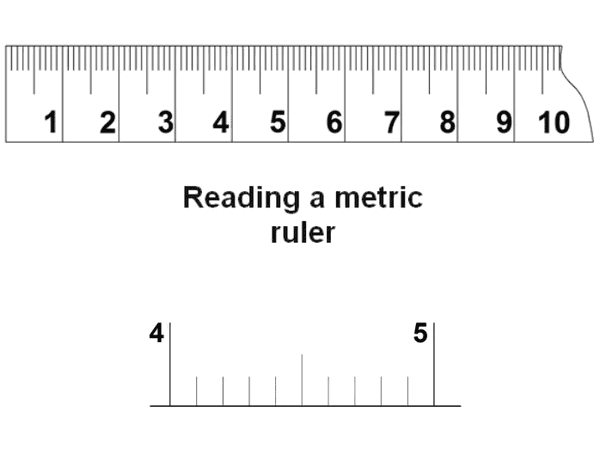


Measure of Lengths – Conversion Table Millimeters (mm) to Centimeters (cm) to Decimeters (dm) to Meters (m) Conversion Chart mm

Each line (1 mm) on a metric ruler represents. Ten lines or millimeters make up a centimeter. The bigger lines with the numbers make up the centimeters. On a metric ruler, each small mark (line) represents a mm. Most measurements in science class are done using a smaller scale then a meter which is either centimeter (cm) or millimeter (mm). In the metric system, the meter is the the standard unit for measurement. Reading Ruler Measurements – Metric System The 100 mm (10 cm), 200 mm (20 cm), 300 mm (30 cm), mm – millimeters, cm – centimeters rulers are using the metric system. Rulers can vary in length and systems, like the 6” and 12” (in or inches) ones, they are using imperial system. These type of rulers have different names such as plastic or wooden rulers, architects scales, carpenters rules, seamstress tapes, measuring tapes and yardsticks. Like most rulers, they are mostly used in school for math, geometry and technical drawing, as well as the engineering and construction, carpentry, sewing, printing and many more other industries. These type of rulers for precision measurements may be have to be certified by NIST (National Institute Of Standards and Technology), to be more accurate, by the Dimensional Metrology Group of the US government. When it comes to accuracy the best material for a ruler has to be steel which is durable and rigid. In our case, the rulers you will find here are made to be printed on sheets of paper. Depending on the rigidity, lightweight or how often will be used, rulers can be made out of different materials such as metal, wood or plastic.
#Read metric scale ruler how to
In this video you’ll learn how to use a scale ruler for architecture and engineering.A ruler, also known as “rule” or “line gauge”, is a thin rectangular measuring device that has straight edges and length measurement markings, equidistant & parallel lines with numbers, along the edge. If you want to draw a 300mm thick wall at 7mm long, all you need to do is follow your scale ruler. If we navigate to our 1:100 scale, it will actually tell us what 7m would look like on paper. In fact, the solution is your scale ruler. Do you have to divide every single measurement by 100 in order to draw this drawing? The answer is no that would suck if you had to calculate every dimension. Let’s also say it got a length of 7m long. So, the 300mm wall would be drawn 3mm wide on paper in a 1:100 drawing. So, drawing a wall that’s 300mm thick, in a 1:100 drawing, would be 100 times smaller than that. So, what does this actually mean? Your teacher wants you to draw your design 100 times smaller than what it would be in real life. – this is quite a typical scale for a floor plan, elevation or section. Let’s say your teacher has asked you to draw a floor plan at a scale of 1:100.

I’m going to take a stab and say you’ve been given the task to draw a drawing at a certain scale. The best way to learn how to use a scale ruler is by using one. The reason why these are at the scales they are, is because they are easily divisible. I see quite a lot of students make their drawings in random scales to fit them on their poster or drawing set.
#Read metric scale ruler professional
You won’t see any scale rulers or professional architects or engineering drawings at random scales such as 1:7, 1:52 or 1:300. Notice how these are all easy numbers to remember. For example, a cabinet doesn’t need to be shrunken as much as a whole house would need to be to fit on a page. They come with different scales because you often need to represent things at different scales. Scale rulers come in different shapes and sizes, but they all do the same thing. As a refresher, from the “how to read and draw a scale floor plan video”, drawing to scale is drawing an accurate representation of something, usually in a shrunken version of itself. In my first year of architecture school I was introduced to working in scale.


 0 kommentar(er)
0 kommentar(er)
